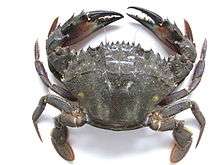Grapsoidea
| Grapsoidea | |
|---|---|
| | |
| Purple shore crab (Hemigrapsus nudus: Varunidae) | |
| Scientific classification | |
| Kingdom: | Animalia |
| Phylum: | Arthropoda |
| Subphylum: | Crustacea |
| Order: | Decapoda |
| Infraorder: | Brachyura |
| Section: | Eubrachyura |
| Subsection: | Thoracotremata |
| Superfamily: | Grapsoidea Macleay, 1838 |
| Families [1] | |
| |
| Synonyms | |
|
See text | |
The Grapsoidea are a superfamily of crabs; they are well known and contain many taxa which are terrestrial (land-living), semiterrestrial (taking to the sea only for reproduction), or limnic (living in fresh water). Another well-known member with a more conventional lifestyle is the Chinese mitten crab, Eriocheir sinensis.
The delimitation of the Grapsidae and Plagusiidae is in need of revision; the latter at least is not monophyletic. The same apparently holds true for several genera in the Sesarmidae.[2][3][4]
The closest living relatives of the Grapsoidea are the Ocypodoidea. In fact, they seem to be paraphyletic with respect to each other and it seems warranted to merge the Ocypodoidea into the Grapsoidea.[4]
References
- ↑ Sammy De Grave; N. Dean Pentcheff; Shane T. Ahyong; et al. (2009). "A classification of living and fossil genera of decapod crustaceans" (PDF). Raffles Bulletin of Zoology. Suppl. 21: 1–109.
- ↑ Christoph D. Schubart; José A. Cuesta; Darryl L. Felder (2002). "Glyptograpsidae, a new brachyuran family from Central America: larval and adult morphology, and a molecular phylogeny of the Grapsoidea". Journal of Crustacean Biology. 22 (1): 28–44. doi:10.1651/0278-0372(2002)022[0028:GANBFF]2.0.CO;2.
- ↑ Christoph D. Schubart; Hung-Chang Liu; José A. Cuesta (2003). "A new genus and species of tree-climbing crab (Crustacea: Brachyura: Sesarmidae) from Taiwan with notes on its ecology and larval morphology" (PDF). Raffles Bulletin of Zoology. 51 (1): 49–59.
- 1 2 Christoph D. Schubart; S. Cannicci; M. Vannini; S. Fratini (2006). "Molecular phylogeny of grapsoid crabs (Decapoda, Brachyura) and allies based on two mitochondrial genes and a proposal for refraining from current superfamily classification". Journal of Zoological Systematics and Evolutionary Research. 44 (3): 193–199. doi:10.1111/j.1439-0469.2006.00354.x.
External links
 Media related to Grapsoidea at Wikimedia Commons
Media related to Grapsoidea at Wikimedia Commons
This article is issued from Wikipedia - version of the 5/31/2016. The text is available under the Creative Commons Attribution/Share Alike but additional terms may apply for the media files.
